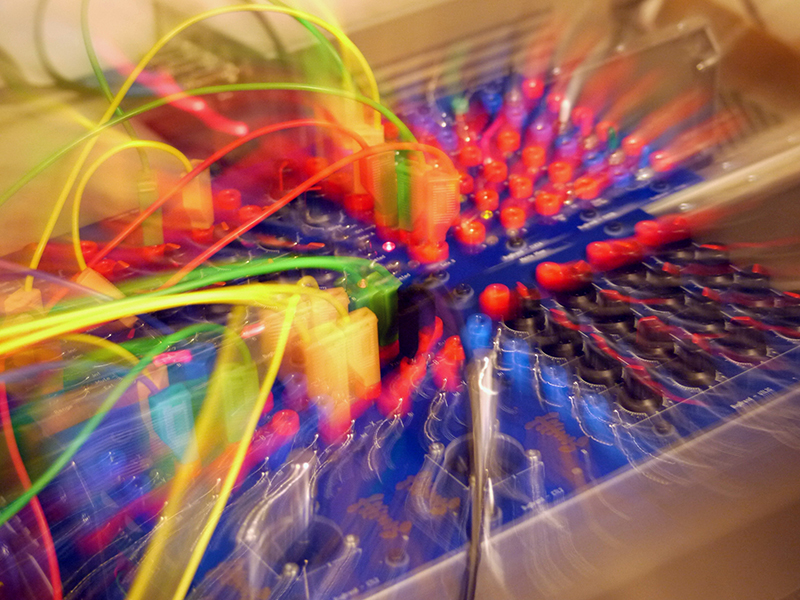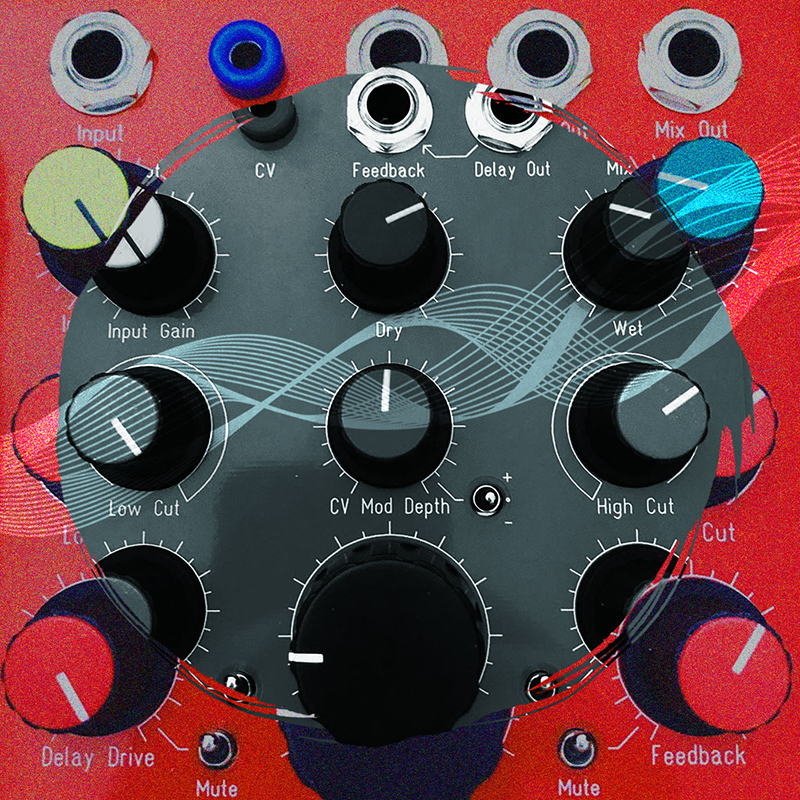
A couple of years ago I was introduced to BugBrand by Gino Robair who – recording his Session, our #12 – used the Chirper, a Synth Voice + a DDSR controlled with a Joystick/Touch module and was really enthusiastic about Tom Bugs’designs…
Later on Miguel Frasconi recorded his Session, our #040, using 2Frame, with a PTDelay and Spring Tanker while at the same time I was welcoming Palle Dahlstedt on our hommage to Metasonix. In fact I soon found out that Palle was owning everything BugBrand and even testing prototypes for the company. My blood ran cold and I decided to take the opportunity to gather more information about the brand so that we could feature in I.T.A.T.I.O.M.
Tom appeared to be a nice gent, available and happy to lend himself to the game of the interview. To do so, our friend Palle Dahlstedt agreed to share his knowledge with us and make it possible by talking to Tom during a Zoom meeting.
Palle has also made sure we get some appropriate pictures from his instruments…
Soon after finishing a technical engineering degree, Tom Bugs came up with the idea of the Weevil « based around lofi square-waves ringmodulated, with power starvation & body contacts » and sold those from 2005 to 2015. Working out how to develop BugBrand, he helped out at the Cube, (a co-op run arts space central to Bristol’s independent creative community) and throughout the years BugBrand produced a fine handful of innovative tone bending devices, from the stompbox-style BugCrushers through the various Weevil incarnations, modular analogue Synth Voices and quite a few impressive standalone Delay, Stereo Processor, Filters, DRM, Chirper… And other enigmatic names which he’ll explain for us in his interview with Palle Dahlstedt.
Palle Dahlstedt: Bugbrand is celebrating 15 years of existence. Would you please retrace your history, maybe some anecdotes, stress some important turning points, milestones?
Tom Bug: I came to Bristol to study something called Music Systems Engineering – it turned out to be very dry & mathematical, engineering based, but I got interested both in the music of Bristol and trying to make my own electronics through, really, trial & error. I found things in the library & on the internet, tried little circuits out & learned, very gradually, from my mistakes. I was more focused on the guitar side of effects, I guess – unipolar powered – the twin rail approach of modular, when I first saw it, confused me like anything, but, then, most things did initially!
Well, I did the course & sometime started helping at the Cube Cinema, doing sound etc. in this wonderful volunteer-run cinema & gig space – oh, and playing in bands & starting out solo too. So I was building little boxes & also circuit-bending, alongside guitar & drums, plus digging in to computer ways.. and making contact mics, lots of them – for mic’ing up anything acoustic, just stick them on, I made loads! Literally as soon as I finished my studies I completed my first ‘batch’ of boxes to sell – I think the one I put on ebay got a good bid & went to Australia, so perhaps that was the lightbulb moment.
So initially I was building the c-mics, trying out some pedals and making the first Weevils – a really simple circuit I found the basis for in a library book for cymbal synthesis – basically two simple oscillators, ring-modulated together. And on to that I started adding circuit-bent features like power starve & touch-points. It was all quite raw sounding and I played a lot with how the boxes were built & presented – cigar boxes, drilled plastic cases, a gradual experimentation. One of the fun early aspects was offering custom Touch Plates – people would send me an image & I would figure it out into a ‘Press & Peel’ circuit board, etching & drilling them all in a very DIY way in my first dark, damp, basement workshop. So, yeah, that was the early days before I started finding out more about modular..

Where, when and how did you first become acquainted with modular synthesis?
There was a single studio with a 2 row Doepfer modular at the university, but the one time I actually got to try it, it seemed like a lot of the sockets were unreliable & really I didn’t have a clue. I also actually worked out at the EMIS store (edge of Bristol – I cycled out there the first week I got to Bristol) which was the UK distro for Doepfer – I didn’t understand very much of it, for sure! Oh yes, from EMIS I got a Nord MicroModular & spent hours on that system – that comes full circle actually with the Doepfer because, as you’ve said to me before, the Nord development team got a Doepfer to help with designing their Modular system – I then played that virtual design and it, in turn, inspired a lot of my ways, still at play today. So physical to virtual and back again.
It took me a while to get my head around how to design for modular systems – the electronic framework. As I said, bipolar power confused me initially – but now, looking back at old guitar pedals etc., I see that it’s all about where the signal is, biasing around it and figuring the wrappings – building blocks (a very modular way, naturally!).
Back then did you decide to make instruments to be used for your own performances?
Sort of.. I tried.. I played around.. The circuit-bent stuff was often too chaotic – like I’ve rarely actually ever played one of my Weevils live. It’s always an exploration, I’m interested in the limitations – what actually makes an instrument. But, anyway, when I began I was experimenting so much with the circuitry and with what I was trying to do musically..
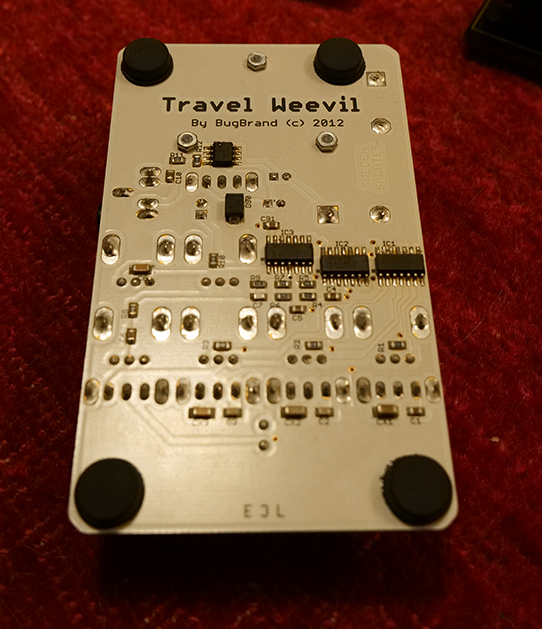
Should we then talk about 2 parallel worlds: making or playing those music machines?
There’s definitely some right-brain, left-brain aspects at play. Early on it was definitely much more a push & pull, as I was really playing a lot of the time, in many different forms, but I think today it has skewed much more to the making side. The thing is is that I often seem to be ripping the ground up under my feet, pushing myself forwards but also tripping myself up. As you’ve pointed out to me, I’m never quite satisfied! Too many ideas & instruments – I always want to have a ‘playable’ studio and have been gradually whittling it down to a setup I like, but I currently don’t get the time in there. Well, I do actually quite like the problem-solving & planning aspects of putting a system or studio together – I just need to make sure to actually play it after all the groundwork!
Once I heard you say that « One should never have a modulation input without an attenuator » which is a dogma you have followed over and that is very different from Eurorack from instance + make your system very workable. One not needing too many accessory modules and being able to fine tune easily which is similar to the Nord way of doing…
True ! Actually it brings to mind Rob Hordijk, who also did a lot of work for Nord Modular and is one of the other individual synth makers managing to follow his own route – both of us being pretty individualistic and trying to find our own design choices – for the whole system setup, really.
That modulation detail has always just sounded logical and natural to me, so I’d say that the balance of an instrument to me is adding the controls necessary & in a playable fashion, while not bundling in the kitchen sink at the same time.
But, yeah, there’s certainly x-million ways to swing a cat, as it were, when designing.
You chose to use Banana Jacks over mini, why? Is it an issue of sonic quality, patching ease, going with the flow?
It is always a combination of dogmatic & pragmatic, maybe with some aesthetic thrown in! I think that once I tried them, they just clicked for me. They were available, reasonably priced, reliable, easily DIY-able.. I certainly liked the stackable, free-flowing & solid feel of them and, of course, the colours. The few times I did try synths using minijacks, I just found myself bumping up against constraints – you needed to plan ahead to when you might need a multiple or even having to patch in an attenuator where, frankly, one should already be present…
The choice of Frac was more pragmatic – cheap cases, though they only came from the US. There weren’t so many choices back then. And somehow I liked the regular widths of the panels – limitations again! So from there it was quite natural, though time consuming, to make my own system structure, initially broadly shared with the already quite niche Frac, but which has subsequently become kind of its own thing.
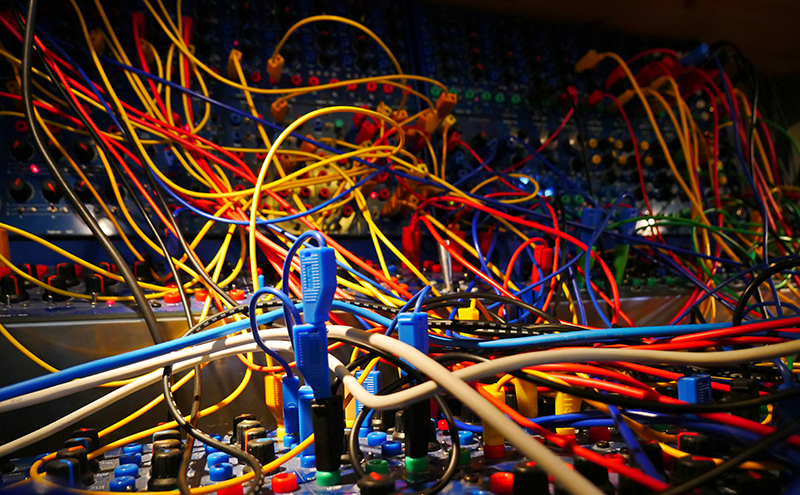
Back then you hadn’t tried some classic « Banana system » like Serge or Buchla?
At some point I did visit EMS in Stockholm (nothing to do with the English EMS!), where they have fantastic old Serge & Buchla setups – in the few hours play I could barely understand the Serge, but did have fun with the Buchla. That’s literally the only real times, I think – ever! While I’ve looked at pics of them a bit, I still don’t really ‘know’ the Serge approaches, some bits absolutely confuse me still, like I can’t ‘read’ the modules, and Buchla, well it’s other worldly, really!
Really, I’ve hardly tried any classic synths or systems – I just read & look, then try ideas out in a way that I imagine might make sense.
Colour is also an important parameter and you have become famous for your bright colors. What motivated the choice of Red and Blue?
I’m wearing a blue T-shirt at the moment ! (Laughters…). So while I don’t tend to go for black/white/grey, there’s certainly also some more pragmatism there – the fact that I could get the banana sockets readily & they came in that range of colours . The four of Yellow, Green, Blue & Red seemed ideal to simply, but effectively help give clarity to module layout. I’ve certainly tried to zone in on standardised parts over the years because I want to be able to readily replicate my designs once I’ve got something figured out – one-off instruments haven’t ever felt viable.
Using PCB material for front-panels seemed much more streamlined & affordable than working with metal – again, colour choice is a bit limited but fine really.. and why stay black & white when some colour is on offer?
Being a longtime Bugbrand user I must say that your panels are really solid, the resin is so hard it is almost impossible to scratch
Yes! They’ve turned out to be very good, actually – though getting them made well, without scratches has been a massive headache at times.

Weak point is getting dusty though (laughters)…
When you decided to build your first modules you called for people who would like to build a system to be in contact with you, I remember that 5/6 replied, how did it turn out?
Yes, I didn’t quite know how to launch something as open-ended as a modular system without getting myself overwhelmed. Everything moves slowly as there are so many aspects – all the cases, power supplies, modules, etc. are built from the ground up, so I tried to be clear and work with only a few people. The mix of honesty and hope – not to promise things that can’t be delivered, but also highlight the ideas and what was still developing. The approach of working in batches seems to have kept things spinning OK for me – I’ll order a run of circuit boards and then make up, say, 10 or 15 at a time. Really it is all baby steps & iterations – working things out gradually.
You follow an aesthetic, often mention the word « community » and want to stay close to your « users », you set up a forum and have been asking how we use your modules ?
Well, it can feel a bit remote at times, as it is mostly online and, as I’ve said, I’m fairly individual in my ways, but I’ve absolutely loved the flow of ideas and surprises that have arisen from people who’ve stuck with my instruments. How we did the early days of the modular, the old blues, was definitely fun with lots of feedback – it was amazing to see what grew and to hear the results. It is deeply heartening still to work with people over the years and, I guess, it highlights why keeping it small really works for me.
What is the best way to get your modules, ordering from you?
Yes, I still do most things direct, though a few stand-alones go to a handful of specific shops – certainly with the modular a fair amount of discussion and gradual building is necessary, so direct works best, though I keep on wondering about more specified or pre-configured setups. Both how to actually get all the modules ready at one time, and how to get a stable instrument, not vanishing down the modular more-more-more wormhole. Certainly I’ve liked the ‘block’ feel, physically and aesthetically, that the 2Frames currently offer – such setups make a nice instrument with enough scope but also building in good limitations.
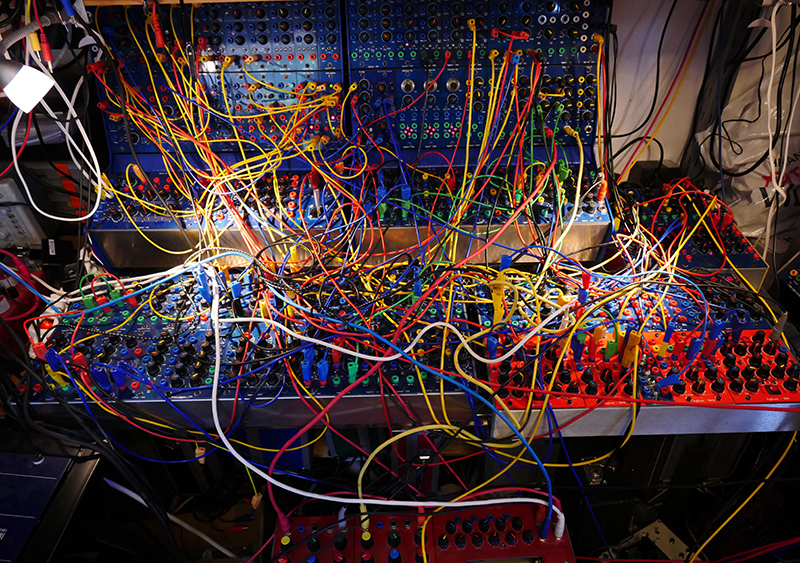
What does inspire a new module design? How do you plan the « Happy accidents » which gives character to our favourite modules, what makes your system, way of thinking unique?
A lot has been curiosity – reading about something and then wanting to try it out. Or seeing a chip and then trying to build a module around that – working out the wrappings at a circuit level while, as mentioned, also trying to figure out what controls to offer and what not to include. I’m something of a sloppy over-thinker – module ideas will filter for months or years even, in a kind of iterative way, and I feel like I’ve always got a good few core idea areas that I could get on exploring. And then there’s also the natural constraints of the system layout – working with somewhat standardised layout approaches & certainly the parts I use. That’s what I’ve built up over the years..
Once you said it was like cooking so how do you respect a balance, create your recipe. How do you cook your modulars out?
To use a cooking analogy, trying to use just a few good basic ingredients and build them up together. I start with a seed idea and then jump back and forth between panel layout and circuitry blocks – it’s quite a problem-solving sort of approach.
Take, for example, the PT Delay – I’m glad to have found a nice, effective layout and then produced that, with few relatively few changes, over a few years. Though alongside, in the back of my mind, has been a more tricked-out version – I’ve come up with full panel layouts, but still haven’t come up with anything concrete.
I do like quite an immediate and simple approach, certainly with machines I’ve played, so I dropped any idea of microprocessors or menu-diving long ago. I guess I like analogue mixing desks – you kind of know where you are! I try to design things stable, but also so that when a system is put together you can get to the happy accidents.
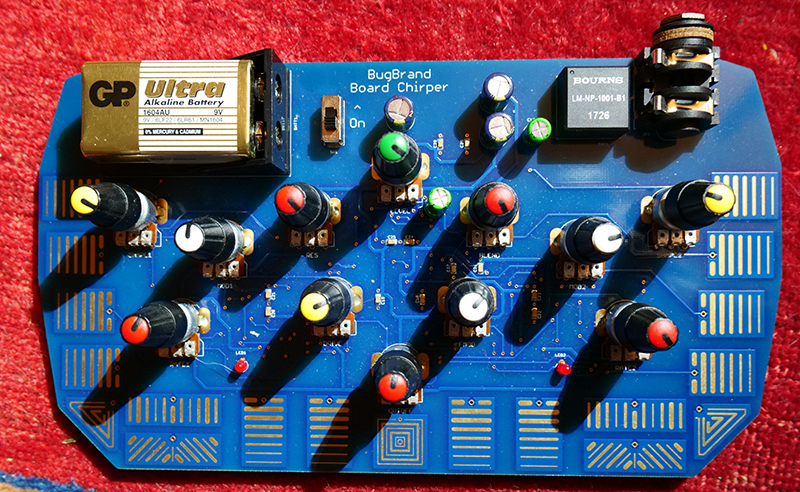
I can think of 2 periods in your Modular life, from 2009 to 2013, then you took a break when you became a father. And then came out the Standalone Red boxes being more for production with Audio jacks in & out and Bananas for modulation. Then you started making some newer Blue ones, full on modular systems again but incorporating different solutions to your circuitry.
Do you still hold the same design aesthetics, ethics, goals and intentions as you did when you began? Are there any major changes over time?
A lot has stayed pretty consistent in many ways – I kind of eased back into doing modular again and it was actually really good to have that break. The old-blues era set up the main system structure, then I came back and refined it for the current modules. The circuit-side of things definitely improved with the break – there were a few core areas, including using the 2164 Quad-VCA chip that forms the hearts of most of the SynthVoice modules. It’s a really great chip!
When I brought out the SynthVoice I imagined further full pre-configured frames to compliment, but in practice it turned out to be right back in to being fully modular.
You certainly chose to keep it simple, and even sacrificed some modulation possibilities to make it user-friendly…
Well, yeah – I did cut out a fair bit, largely because of trying to make a perhaps more ergonomic layout. So it is quite simple, bringing together all the elements of the classic ‘subtractive synthesis’ methods – but there are always the little extra touches that I try to incorporate. Having played with it now for a good few years, there are times when I’d like some similar but slightly expanded versions of some of the modules – I guess this highlights just what you said about never quite being happy! But, equally, I’ve kept the designs going and do think they do a good job – limitations but possibilities.
For example, the filtering – I’ve pretty much stuck with 12db/oct State-Variable Filters, using them regularly over the years & gradually refining the core. The Dual Filter is just one possible implementation really – it fits a good bunch of utility into the 2FW space, though I sometimes wish for a single more expanded version, probably more for pinging than regular filtering.
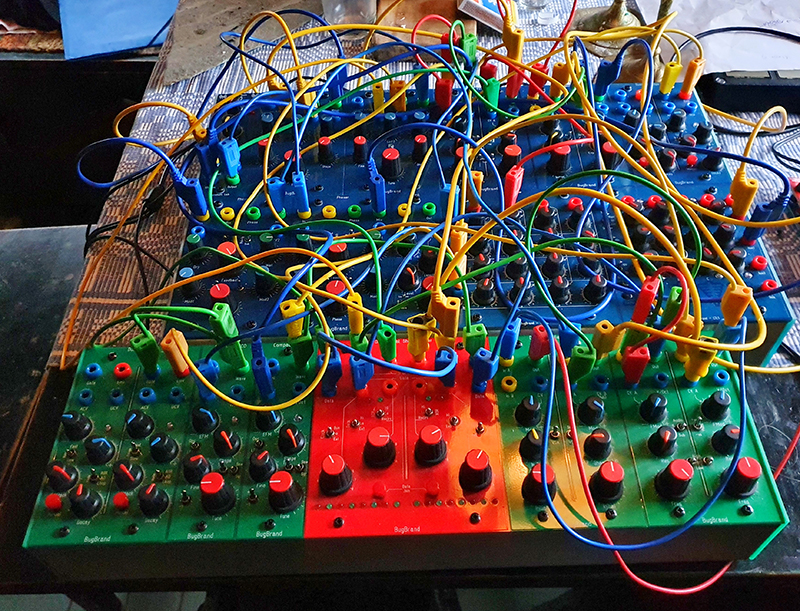
Well many don’t know that your filters are Patch-programmable just like the Serge filters, they can become quadrature, oscillators and all kinds of weird wave shapers too.
I often seem to forgot about this – you as a beta tester always find so many different ways with a module to make it widely useful… At a circuit level the feedback paths has some very interesting possibilities – the Quadrature Sine is actually very similar in many ways to the State-Variable Filter.
On another note you do have a drumming background and you have always been interested in rhythms. Your modules always had a strong focus on clocking, dividers, Logic, generating irregular rhythmical patterns…
Definitely ! I love the physicality and directness of drumming – actually, in many ways Modular Synthesis has still not been able to give anything like that physical feeling of acoustic drums, but it offers many other wonderful possibilities in a more programming sense – probably more mind based than the body base of acoustic drumming.
The clocking stuff, self-generating rhythms, definitely stems a lot from using the Nord Modular – it was a great way to explore how divisions could be combined into something less 4/8/16 structured, keeping a pulse but getting away from the repeating pattern. It really is where the surprises lurk – which is surely something exciting for the solo musician – although then capturing them can be elusive.. it often feels ephemeral and something of a rolling, play-fight.

You grew up learning music, playing instruments, back in the early 2000s you started volunteering at the Cube Cinema in Bristol which was an important venue for Cinema, Art, Live music… Do you compose or perform music — or don’t you have time to do so?
I spent a good chunk of time at the Cube, both attending and doing sound there – I saw the most amazing shows in the cinema space, so different from many other gig venues! It was very formative for me – meeting musicians & seeing how it could be done (differently!), the amateur (for the love! A positive!) approach to making things happen, the chaos, the people..
I did play a lot more then, though I don’t get to do it so much these days – yes, I grew up playing from an early age & then became more exploratory – by the time I was in Bristol, I played in various bands and also started doing my solo things. Sort of song-based electronic stuff but then the open-ended nature of the modular investigations sent me a bit wayward – as I say, it is quite of-the-moment. Actually I have hours of recordings, as I’m sure many people do, but to me these do not need be released, I am not really composing or anything and try to simply enjoy playing. Though sometimes it is nice to put something out..
Indeed I heard that some people were playing music before recorders were invented so there must be some other reasons than playing in hope to be released…
Ha, right, though you may want something easier than a modular for that (Laughters). There’s an endless balance-battle of possibilities versus Keep It Simple, Stupid (KISS!) – I’ve so much respect for someone who can stick to a constant instrument!

Talking about the complexity of modulars, is there a system you dream of building? Is there a type of module that you would like to build, but that is too expensive (or doesn’t have a big enough audience to support making it)?
I’m kind of happy with how things are at the moment – I still play around with slight expansion & contraction of my own personal systems, but have found that a few frames, coupled with an external mixing desk and a few red-box effects, gives a good ‘playground’.
I do want to get back to more playful areas. I’ve always been fascinated with solar powered possibilities – self contained, self powered systems that would react to light. A year or two back I tried doing ‘Solar Chirpers’ but the location they were put didn’t really work as it didn’t get enough light and so that area has kind of gone back to sleep again for the moment, but a friend has been asking some questions recently so…
I also always wanted to do a system which was based on bikes, both for self-powering & the possibilities of the sound spatialisation – the audience with cyclists whizzing around them emitting sounds!
I know you are really interested in body controlling, developed some touch sensors where the body could become part of the circuit. What are you up to with that approach?
For sure Michel Waisvisz’s CrackleBox was an influence – I went over to STEIM a few times when I started out. Because of that physical interaction possibility, circuit-bending touch but also as a self-contained instrument. I replicated that idea with my postcard Weevils that had batteries and speakers so that they were like acoustic instruments despite being electronic.

Do you feel close to other makers and/or designers? You mentioned Rob Hordijk earlier on…?
Yes I met him a couple of times and I guess we are both sort of cranky individualists.
Aesthetically, back to the roots, I feel closer to Serge and Buchla’s realm of doing things as surprising systems rather than key-based synthesisers, though in terms of history and lineage they are at the top of it all whereas I’m just a pale inventor in comparison.
There’s some interesting small scale stuff going on in the 4U banana worlds for sure at the moment, but when it comes to Eurorack it really is too much for me, I can’t get close to the business side of it and only keep half an eye on what’s happening – it is such a constant churn. But there are some makers with clear vision & consistency – Emilie Mutable, in particular has beautiful design aesthetics & open source ethics, and I’m impressed by how far several designers have come in the last decade. Hats off to Makenoise with their standalone designs, Danjel Intellijel’s clarity.. So, yes, clearly I have some liking for the unified vision of single manufacturers and how that develops over time.
Speaking of that Open Source ethos, for instance Scrotum Lab has been porting some modules (Radio Music, Orgone Accumulator) to your format, could this happen more? How do you feel about that?
I’ve really enjoyed Robert (Batchas / Scrotum Lab) bringing some modules to the system & we’ve worked a bit together on it, though really it has been his endeavour. He’s also a good player of his BugBrand system & his additions definitely add to the fun & rhythmics. Unfortunately he has found that being a niche within a niche is hard to ‘make work’ – certainly all the design & sourcing aspects (alongside French taxes). Getting reliable quality panels proved a massive headache for him, just as it has been for me.
You appear to be friendly and open to collaborations but there are some practicalities which makes it not viable…
While ideas tend to be easy, making them happen isn’t. As I say, there are many areas that have to interlock to make something ‘work’, though there’s a load to be learned through trying.

That would be true for most things in life. What have you been working on lately, and do you have any secret upcoming modules?
As hinted, I’ve always got a fair few ideas on the slow boil – there’s definitely been people asking for me to finally do a Noise/Sample&Hold module and I thought I’d got it all sussed, something similar to the old NoiseCrusher design, but then a little niggling issue cropped up and I’ve still not managed to move it forward months later..
I tend to keep designs a bit close to my chest nowadays – largely because I know how many unforeseen issues can crop up & cause delays. But, yeah, I’m hoping to get a Sequence design out shortly and am looking forward to trying out re-evaluating another old classic area from my Old Blues, but don’t want to give the game away yet on that!
And don’t even get me started on the whole other world of apples & cider that I’ve been sinking in to the last few years
Do you have any advice you could share for those wanting to start or develop their own “Modulisme”?
Slow and steady, that’s me (Laughters)
Tom’s own youtube channel:
https://www.youtube.com/user/BugBrand/videos
Gino Robair
https://modulisme.info/session/12
Miguel Frasconi
https://modulisme.info/session/40
Palle Dahlstedt’s channel offering Bugbrand videos:
Batchas’ channel on Bugbrand:
Bugbrand compilation from 2019, released by 0pr music:
Bugbrand Blue
https://0prmusic.bandcamp.com/album/bugbrand-blue
Bugbrand Red
https://0prmusic.bandcamp.com/album/bugbrand-red
Music by Tom Bugs
https://bugbrand.bandcamp.com/album/la-dur-e
https://bugbrand.bandcamp.com/album/modular-mixer-1
https://boomkat.com/products/living-leaving
Last but not least, a complete list of Bugbrand music:
https://modwiggler.com/forum/viewtopic.php?t=252202&p=3677138#p3677138
